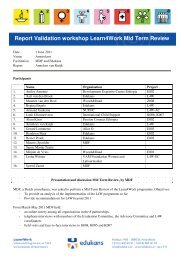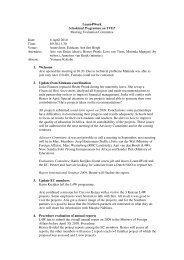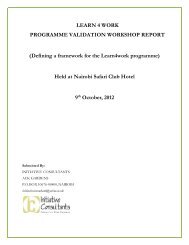DRAFT TECHNICAL AND VOCATIONAL EDUCATION AND ...
DRAFT TECHNICAL AND VOCATIONAL EDUCATION AND ...
DRAFT TECHNICAL AND VOCATIONAL EDUCATION AND ...
You also want an ePaper? Increase the reach of your titles
YUMPU automatically turns print PDFs into web optimized ePapers that Google loves.
1.0 GENERAL INTRODUCTION<br />
1.1 Problem and Purpose<br />
From global and national policy perspectives, the provision of technical and vocational and<br />
education and training (TVET) is viewed as a necessary intervention in attempts to empower<br />
people, reduce poverty, and realize the Millennium Development Goals (MDGs). The logic<br />
is that if people, especially the youth, are equipped with employable skills with which they<br />
can access labour markets, then the incidence of unemployment, poverty, and other<br />
undesirable consequences of social and economic exclusion would be reduced. Concerned<br />
about the plight of marginalized and vulnerable groups in developing countries and the slow<br />
progress towards the achievement of the MDGs, the Government of Netherlands launched the<br />
Pact of Schokland which will broaden Dutch efforts in development cooperation beyond the<br />
traditional agencies to include civil society organizations and the business sector. “Improving<br />
Access to Good Technical and Vocational and Education and Training in Developing<br />
Countries” is one component of the Pact. Ethiopia, Ghana, Kenya, and Zambia have been<br />
selected under the Pact for North-South cooperation among vocational education providers<br />
towards capacity building and improvement in access to good-quality TVET. As a first step,<br />
a mapping exercise is to be undertaken in the four countries for the development of relevant<br />
and coordinated partnership activities.<br />
The overall objective of the mapping exercise is to describe the policy environment<br />
for TVET provision in the selected countries, actors involved, the current state of<br />
TVET demand and supply, achievements, student transition from school to work,<br />
intervention strategies in place for labour market development, challenges, strenghts<br />
and weaknesses, opportunities and threats, and lessons learned from past<br />
interventions. The mapping exercise in Ghana will lead to the identification of<br />
options for entry and support to the TVET sector within the context of the Dutch<br />
Schokland TVET Programme with special focus on marginalised and disadvantaged<br />
groups.<br />
1.2 Socio-Economic Context of TVET in Ghana<br />
Ghana, one of the five English-speaking members of the Economic Community of West<br />
African States (ECOWAS) occupies a land space of 238,533 square kilometres and recorded<br />
a population of 18.9 million people during the 2000 census. The country’s population<br />
growth rate is about 2.7%, having dropped from a high of 3.0 but still far from replacement<br />
rate. Within four decades (1960-2000) the country’s population virtually tripled in size from<br />
the 1960 figure of 6.7 million and recent estimates put the population at 21.1 million in 2005<br />
(Ghana Statistical Service, 2005 and 2006). A country profile of Ghana providing highlights<br />
of demographic and socio-economic indicators is presented in Appendix A1 to Appendix A5<br />
for further understanding of the context of the programme.<br />
According to the 2000 census figures, females accounted for 50.52% of the population but<br />
2005 estimates put the female population at 50.49% of the total. Also, approximately 41% of<br />
Ghana’s population consists of children below 15, and youth in the 15-24 age range constitute<br />
18 per cent of the total population while people in the 25-59 age range account for about 33<br />
per cent (Ghana Statistical Service, 2006, pp. 3-4). The country is still in a transition from<br />
high fertility to low fertility, and its population growth is expected to run into the latter part of<br />
21 st century even though replacement fertility level might be reached by 2035.







